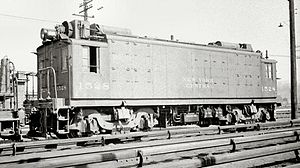GE three-power boxcab
| GE three-power boxcab | |
|---|---|
|
GE three-power boxcab from New York Central , around 1930
|
|
| Number: | 41 |
| Manufacturer: | ALCO , GE |
| Year of construction (s): | 1928-1930 |
| Axis formula : | Bo'Bo ' |
| Gauge : | 1435 mm ( standard gauge ) |
| Service mass: | 115.7 t |
| Top speed: | 64 km / h |
| Hourly output : | 1180 kW |
The GE three-power boxcab was a series of diesel-electric boxcab locomotives which, as two -power locomotives , could also be operated purely electrically . The machines built by the American Locomotive Company (ALCO) were created with the assistance of General Electric (GE) and were the first of their kind. Since the word diesel was frowned upon in the USA after the First World War , they were referred to as "Oil battery electrics" .
prehistory
The tracks to the terminus Grand Central Station (since 1913: Grand Central Terminal ) in the Manhattan borough of New York City lay in a four-kilometer underground section from which the authorities wanted to ban steam operations as early as 1902 . Poor visibility in the smoke-filled tunnel led to a railway accident in February of that year with 15 dead and 41 injured. The conversion to electrical operation was required by law by July 1, 1908.
Approached was the station of the trains of the railway company New York Central and Hudson River Railroad (NYC & HR, later in the New York Central Railroad merged), which tracks the New York, New Haven and Hartford Railroad used (NYNH & HR). At the end of September 1906, the first section between Grand Central and High Bridge ( Harlem ) was electrified with side busbars and 650 V DC . The locomotives were changed at High Bridge station. By the beginning of 1913, the electrical network was expanded to a length of around 100 km.
In order to be able to reach the major New York stations without changing locomotives , the companies procured multi-system locomotives and multiple units for two or even three power systems. An early example of this is the New Haven EP-1 , of which 41 locomotives were built between 1905 and 1908. Later, however, there was also the option of building diesel locomotives accordingly. It was, - in so far only as shunting locomotives built - machines in the United States to diesel-electric vehicles whose driving axles of electric motors have been moved. The companies ALCO and GE had developed such locomotives with the ALCO boxcabs by 1925 , 33 of which were built by 1928. The first two-power locomotives that could also be used on the tracks of the Grand Central Terminal in the tunnel were the three-power boxcabs built by these manufacturers.
history
In 1928, ALCO and GE delivered a prototype to the New York Central Railroad (NYC) for shunting operations on electrified and non-electrified tracks , which was given the road number 1525. It differed from the following series machines in that it had a central driver's cab . After its successful testing, a consortium of four companies built 40 locomotives, the superstructures of which, however, had two final driver's cabs in accordance with ALCO boxcabs. The frame , the box and the running gear came from ALCO, the generator , the traction motors and the electrical system from CE . Ingersoll Rand supplied the diesel engine and the Electric Storage Battery Company supplied the batteries.
The locomotives were mainly used in inner-city areas, where e.g. B. an emission-free operation was required on tracks leading in factory halls. Most of the machines ordered the New York Central Railroad and used them in New York City on the West Side Line and the High Line . Locomotives of this type also ran in Detroit and Boston . For the Rock Island Railroad in Chicago , such a locomotive was shunting at LaSalle Street Station .
In the 1960s and 1970s, the GE three-power boxcabs were shut down and then scrapped.
description
The GE three-power boxcabs were regular gauge locomotives with the wheel arrangement Bo'Bo '. The 115.7 t heavy machines had four drive motors of the type GE-286-B, which got their power from batteries. These in turn were charged with a DC voltage of 600 V via a generator that was driven by a diesel engine . 34 of these locomotives were also able to draw their power directly from a busbar on the side , two machines from an overhead line carrying 3000 V DC .
The six-cylinder four-stroke diesel engine developed 224 kW. It was used to charge the batteries as they could not be charged via the 600 volt power rails. The maximum speed of the locomotives was 64 km / h; however, they ran at a maximum of 31 km / h in busbar mode and at 14 km / h in battery mode.
Individual evidence
- ^ Mark Garrett: Encyclopedia of Transportation: Social Science and Policy . SAGE Publications, 2014, ISBN 978-1-4833-4651-9 , pp. 469 ( limited preview in Google Book search).
- ^ New York Central System Locomotive Roster, 1940, p. 85 at railarchive.net, accessed on February 10, 2020
- ↑ a b Stefan Vockrodt: Electrically to Manhattan . In: Railway history special . Railways in New York No. 1 , 2013, ISBN 978-3-937189-77-2 , pp. 50 ff .



